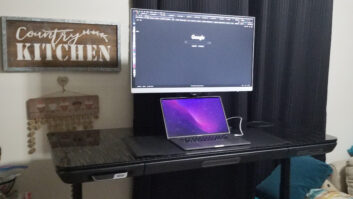Fort Worth, Texas — Strong sales and preservation of gross margin were the two keys to higher operating and net earnings at RadioShack during the retailer’s fourth quarter and for the year, while a dramatic overhaul of store design, assortment and systems will lead the chain to greater long-term growth, the company said.
Operating income climbed nearly 3 percent in the three months, ended Dec. 31, hitting $212.5 million, up from $207 million in the same quarter in 2003. For the 12 months, operating income moved up 15 percent, hitting $558.3 million, compared with a year-earlier $483.7 million.
Net income in the fourth quarter rose 3 percent, reaching $130.9 million, from $127.3 million in the same period the previous year. For the 12 months, net income jumped about 13 percent to $337.2 million from $298.5 million.
As reported in mid-January, RadioShack fourth-quarter sales climbed 7 percent to $1.6 billion, from $1.5 billion year-on-year, while comp-store sales for the period rose 3 percent. Sales for the 12 months increased 4 percent to $4.8 billion from $4.6 billion, while comps moved up 3 percent.
“RadioShack had an outstanding 2004,” said Len Roberts, chairman/CEO. “The company generated higher sales growth, expanded gross margin, leveraged SG&A [earnings] and increased operating income by 15 percent. Strong sales and gross margin preservations were the keys to delivering higher operating and net profits.
Roberts went on to say, “The difference between comparable and total sales in the fourth quarter of 2004 was the result of the first step in our plan to expand channels and to position the company to deliver higher growth. Our investment in strategic growth channels, such as Sam’s Club and Sprint kiosks, impacting SG&A in the fourth quarter, will serve as a platform for profitable growth going forward.”
RadioShack’s computer business led fourth-quarter sales, rising 27 percent, as sales of digital imaging, home networking and surveillance products led the way. Wireless communications climbed 13 percent on the strength of subscription and handset sales from Verizon and Sprint.
On the downside, home entertainment sales in the fourth quarter were off 16 percent, due to lower sales of audio/video and accessories. Wired communications sales were down 15 percent, mainly because of slower sales of telephones and accessories.
In a conference call, held last week during the company’s annual investor conference, president and CEO-elect Dave Edmondson outlined a sweeping, multi-pronged plan to rejuvenate RadioShack’s stores and customer base. The core of the strategy is the system-wide rollout of 13 standard operating procedures (SOPs) designed to improve the in-store experience, which now varies widely from location to location, he conceded.
The SOPs, which will be implemented by September, include such disciplines as accurate pricing, floor replenishment, shipments received and labor scheduling. The company projects that the improvements will yield an additional $200 million in annual sales.
Edmondson said that RadioShack will also further edit its assortment in pursuit of a narrower but deeper product portfolio, citing 1,200 unproductive SKUs currently on store shelves that cumulatively contribute only $9 million in annual profit. Low-turn SKUs will be moved to the company’s Web site, he said, in order to maintain the company’s exhaustive productive offering.
What’s more, the company will introduce its own version of Best Buy’s customer centricity program by deploying six different store assortments that are customized by demographic area. Edmondson said that his stores’ smaller footprint and trading areas will allow the company to customize its locations to a far greater degree than Best Buy, with its superstore format. He added that the company is also working vigorously to shift its core customer base away from older males.
RadioShack will also install traffic counters in 1,000 stores this year, which will be used with existing transaction tracking systems to better understand customer shopping patterns. Edmondson said that customers enter RadioShack stores with the intent to make a purchase 80 percent of the time, but leave empty handed 50 percent of the time, and he intends to find out why and correct that.
Faced with an aging store base — the average age is 13.5 years —RadioShack will also accelerate its store remodeling program, with 80 percent to 90 percent of existing stores slated for some degree of remodeling this year.
To improve store-level oversight and accountability, RadioShack will also overhaul its field supervision structure. The company is currently conducting a 300-unit test of four new supervision models, one of which will be implemented system-wide in 2006.
At the same time, the chain is implementing such IT initiatives as better forecasting by item, new labor scheduling software and improved promotion planning.
Edmondson said that these improvements will help it better leverage its core infrastructure in implementing new revenue-generating venues, like its wireless kiosk programs, that will change the company from a value business to a growth business. By way of example, he noted that the 546 wireless kiosks that RadioShack rents from Sam’s Club will generate $150 million this year and produce $3,050 in sales per square foot, compared to $342 per square foot for the average RadioShack store, and $1,800 per square foot for the much-vaunted Apple Stores.
The company’s Sprint kiosks, which will multiple nearly tenfold to 500 units by 2007, are even more productive, squeezing out $5,000 in sales per square foot, he said.












